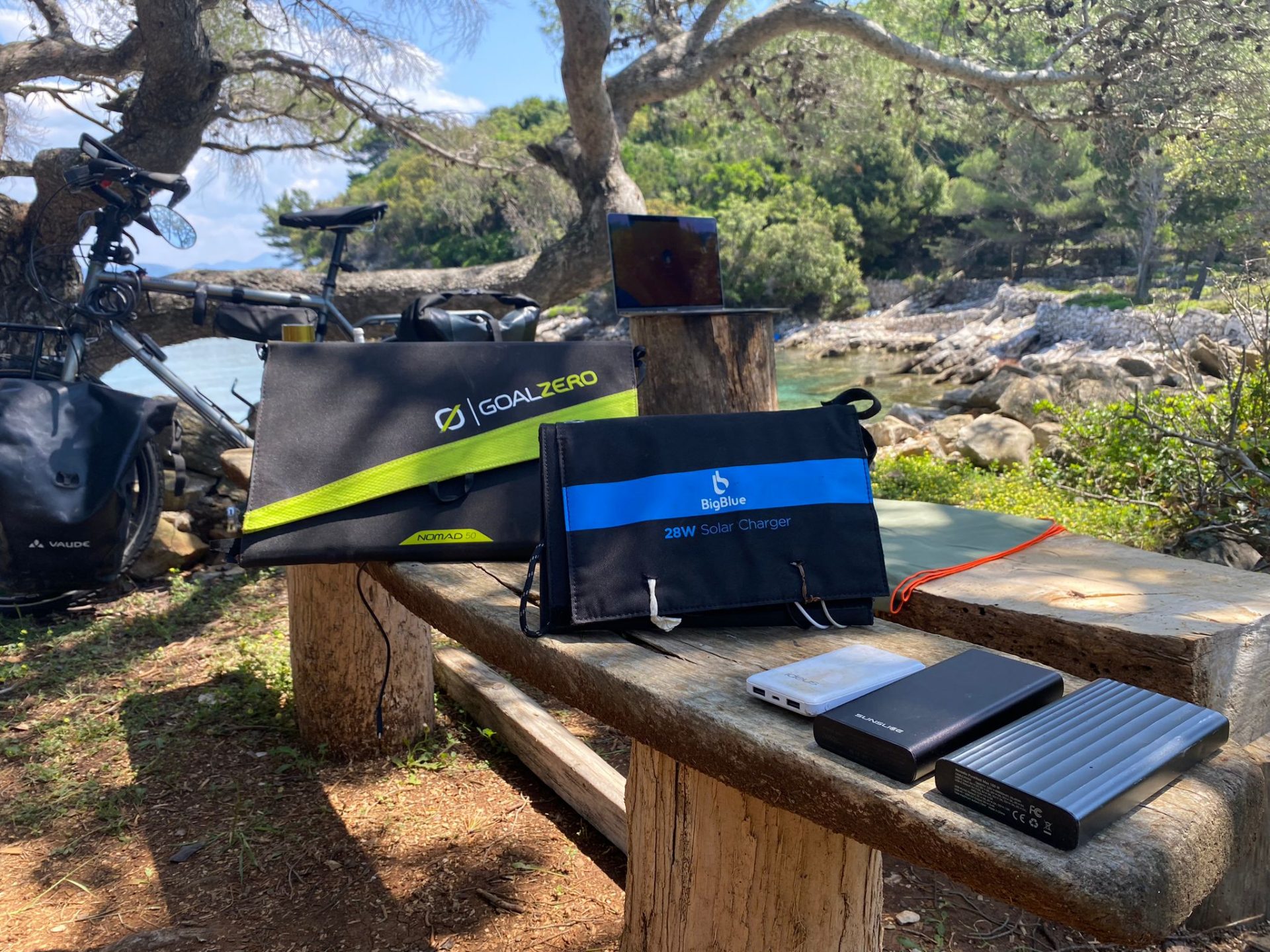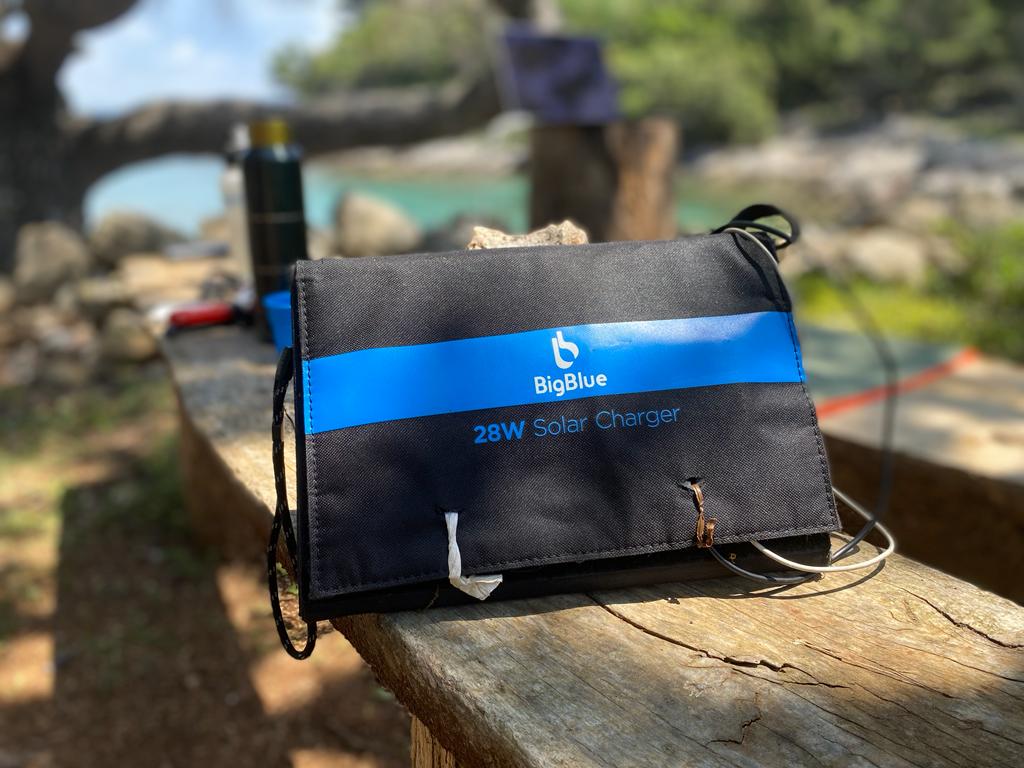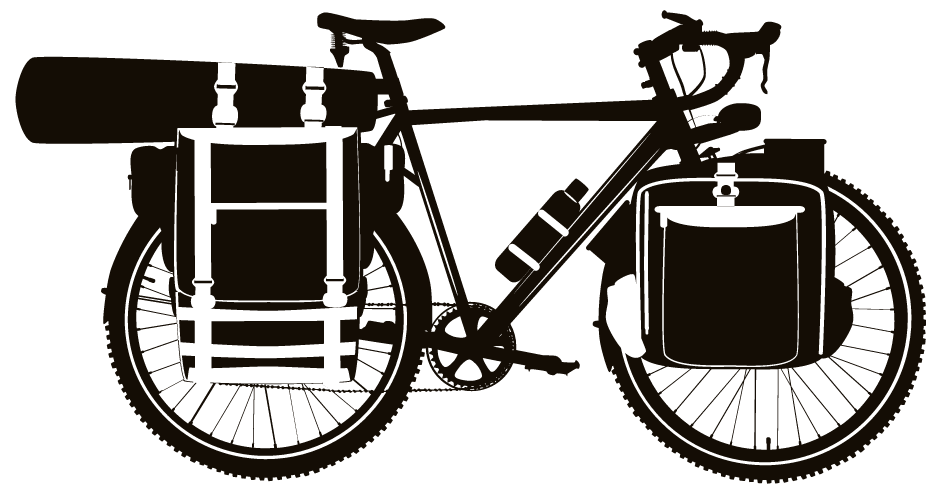My opinion on Goal Zero Nomad 50 and BigBlue 28W solar panels

A brief presentation of my round-the-world cycling trip
With a passion for freedom and a love of nature, I've embarked on a daring and inspiring cycling trip: a journey across the world, from the picturesque landscapes of France to the mysterious lands of Asia. A journey spanning several years, my pedals are destined to tread all five continents, totalling more than 70,000 kilometres.
For me, this trip is not a race against time. On the contrary, I enjoy every moment of it, savouring life to the rhythm of the seasons and the passing landscapes. Far from seeking to travel light, I appreciate the comfort and autonomy offered by my equipment.
The cornerstone of this trip is autonomy. I want to be able to spend several days in places far removed from civilisation, living by my own rules, free and independent.

Cycling off the grid
Energy self-sufficiency is a fundamental issue when you embark on a long-term cycling trip, especially when you're travelling through isolated regions far removed from the conveniences of modern civilisation. The problem becomes even more complex when you work and do business on the web as a digital nomad, as I do. Maintaining a link with the digital world is vital, as it allows me not only to carry out my daily tasks, keep in touch with my customers and update my websites, but also to share my adventure with my online community.
To meet this challenge, it is imperative to have access to a reliable and sustainable source of energy that can generate the electricity needed to run my laptop, smartphone and other electronic devices essential to my journey. Solar power proved to be an environmentally friendly and practical solution for my cycling trip.
So I decided to travel with two solar panels, the Goal Zero Nomad 50 and the BigBlue 28Wto get the best of both worlds. In this article, I'm going to share my experience with these two devices, in the hope that it might help other travellers and digital nomads in their quest for energy autonomy.

In my quest for energy autonomy, two solar panel options caught my eye: the Goal Zero Nomad 50 and the BigBlue 28W.
Le Goal Zero Nomad 50As its name suggests, the 50-watt charger is ideal for charging high-capacity batteries. It is designed to be lightweight and portable, with particular attention paid to durability and efficiency. Its solar panels are protected by a robust, weatherproof casing, making it particularly suited to the harsh outdoor conditions I may encounter on my travels.
Le BigBlue 28Wis a more compact solar panel with 28 watts of power. It's lightweight and foldable, making it easy to carry and store. The BigBlue 28W also has integrated USB ports, making it easy to connect my electronic devices directly to charge them.
These two solar panels are my faithful companions throughout my journey, providing the energy needed to power my digital nomadism. In the following sections, I'll be sharing more about my experience with the Goal Zero Nomad 50 and the BigBlue 28Wto help you understand how these tools can support an energy-independent cycling trip.
Why solar panels?
Energy autonomy is one of the most important aspects of being a digital nomad and a traveller. This is even truer when venturing into remote areas where access to a reliable source of electricity can be a challenge. That's where solar panels come in.
In my case, I use a combination of hardware and renewable energy solutions to stay connected and productive during my trip. My MacBook Air M1 is essential for web development and site management. My iPhone 11 keeps me in touch with my clients and my online community. As for my Insta360 X3 camera, it captures the precious moments and breathtaking panoramas I encounter along the way.
However, all these devices require a source of energy to operate. That's where my solar panels, the Goal Zero Nomad 50 and the BigBlue 28Wcome into play. These two solar panels, combined with my three robust batteries (two 26800mAh 100W and one 10000mAh), provide me with the electricity I need to power my equipment.
Solar energy is an obvious solution for cycling because it is renewable and environmentally friendly. What's more, solar technology has made huge strides in recent years, meaning that panels are increasingly efficient and portable. They can generate a significant amount of energy, even on overcast days, which means I can recharge my batteries throughout the day.
By choosing solar panels as my energy source, I'm not only ensuring that I'm self-sufficient in energy wherever I am, but I'm also helping to protect our planet by opting for clean, renewable energy. It's a choice I highly recommend to all travellers and digital nomads looking to combine adventure and work in a sustainable and environmentally-friendly way.

Goal Zero Nomad 50 solar panel
The solar panel Goal Zero Nomad 50 is an invaluable partner on my journey. It combines remarkable power with efficient portability, offering a reliable renewable energy solution in even the most remote locations.
This panel has 50 watts of power, making it capable of quickly charging my 26800mAh batteries. It has an integrated USB port for direct use, as well as an 8mm port for connecting to larger Goal Zero batteries. Smart features like intelligent charging technology ensure optimum efficiency and protect your devices during the charging process.
One of the most impressive aspects of the Goal Zero Nomad 50 is its durable design. The solar cells are protected by a robust casing that withstands the elements, ensuring consistent longevity and performance, even in harsh conditions. What's more, it's lightweight and its foldable design makes it easy to carry and store when not in use.
Overall, the Goal Zero Nomad 50 is a versatile solar panel that offers an attractive combination of power, durability and portability. It's a wise investment for any traveller or digital nomad looking to ensure energy autonomy on the move.
My personal experience of using the Goal Zero Nomad 50 during my cycling trip.
It's true that I don't use the solar panel Goal Zero Nomad 50 daily, especially on days when I cover long distances by bike. Its extra weight of over three kilograms can be felt during these stages.
However, when I decide to take a break somewhere remote and immersed in nature, this solar panel becomes my precious collaborator. It's essential for recharging my batteries, enabling me to maintain my energy autonomy and continue my work as a web developer, even in the most isolated places on the planet.
Advantages and disadvantages of the Goal Zero Nomad 50
During my round-the-world cycling trip, the solar panel Goal Zero Nomad 50 has proved to be a valuable ally, but it has also presented some challenges. Here's my feedback, detailing the pros and cons of this model.
Advantages :
- Reliability and efficiency The Goal Zero Nomad 50 solar panel has a power output of 50 watts, making it an effective way of quickly charging my batteries, even when I'm in the middle of nowhere.
- Durability : The panel's robustness is a major asset. It has survived a variety of climatic conditions without losing any of its effectiveness. Its water- and weather-resistant construction means it remains operational even in difficult conditions.
- Portability Despite its size, the panel is foldable and compact enough to be easily packed and transported.
- Intelligent charging The solar panel features intelligent charging technology that optimises efficiency and protects my devices during the charging process.
Disadvantages:
- Weight Weighing in at over three kilograms, the weight of the solar panel is the major drawback, especially on long days out cycling.
- Dependence on weather conditions Like all solar panels, its efficiency depends on weather conditions. Cloudy or rainy days can considerably slow down the charging process.
- Prices The Goal Zero Nomad 50 is a significant investment. It may not be the most economical choice for all bike travellers or digital nomads.
It's important to note that my experience with the Goal Zero Nomad 50 solar panel can vary depending on many factors, including geographical location, device usage and weather conditions.
Here is a technical data sheet for the Goal Zero Nomad 50 solar panel
Technical specifications:
- Panel type: Monocrystalline
- Max. power 50 Watts
- Ports: 1 USB port (5V, up to 2.4A, 12W max), 1 8 mm DC port (14-22V, up to 3A, 50W max)
- Open circuit voltage: 18-22V
- Solar cells: Monocrystalline
- Weight: 6.85 lbs (3.1 kg)
- Dimensions (unfolded): 28.5 x 37 x 1 in (72.4 x 94 x 2.54 cm)
- Dimensions (folded): 11.5 x 7.2 x 2.5 in (29.2 x 18.4 x 6.4 cm)
Features:
- Foldable design: Easy to carry and store. The foldable design makes it perfect for use when travelling.
- Durability: The solar cells are protected by a robust, weatherproof casing.
- Intelligent charging: Intelligent charging technology for optimum efficiency and protection of the device during the charging process.
- Compatibility: Compatible with most USB devices and Goal Zero batteries.

BigBlue 28W solar panel
Compact and lightweight, the solar panel BigBlue 28W is a key piece of equipment in my range. This solar panel is designed for portability, with a foldable design that makes it easy to carry and store, even in tight spaces. Despite its small size, this panel is capable of delivering up to 28 watts of power, which is enough to efficiently charge most of my electronic devices, such as my phone, headlamp and camera batteries.
This solar panel is equipped with high-efficiency solar cells that maximise the conversion of solar energy into electricity. It also has built-in USB ports, so I can plug in my devices directly without the need for additional adapters. One of my favourite features of the BigBlue 28W is its intelligent regulation system, which automatically adjusts the output current according to the device connected, guaranteeing safe and efficient charging.
In terms of durability, the BigBlue 28W doesn't disappoint either. Its robust, water-resistant design makes it perfectly suited to the changing outdoor conditions I encounter on my travels. Whether it's blazing sun or pouring rain, this solar panel continues to supply electricity reliably.
Overall, the BigBlue 28W is an excellent choice for anyone looking for a portable and efficient solar power solution. Its combination of power, portability and durability makes it ideal for my digital nomad lifestyle.
My personal experience of using the BigBlue 28W during my cycling trip.
The BigBlue 28W is a major ally in my quest for energy autonomy. Usually attached to the back of my bike, it takes care of recharging my little 10,000mAh battery as I go.
This compact, lightweight solar panel has proved its worth, particularly when charging my iPhone 11. In full sunlight, it takes just one hour to bring my phone battery back up to full capacity. A great advantage when you're constantly on the move.
At the start of my adventure, the BigBlue 28W was my only source of solar power. Its practical size and light weight make it extremely useful for powering all my small electronic devices. However, it's worth noting that it doesn't provide enough power to charge my MacBook Air M1 efficiently, so I had to add the Goal Zero Nomad 50 solar panel to my arsenal.
The advantages and disadvantages of BigBlue 28W
Like all products, solar panels BigBlue 28W has its strengths and weaknesses, which I discovered during my cycling trip. Here's my analysis based on personal experience.
Advantages of BigBlue 28W :
- Compact and lightweight Its compact size and light weight make it easy to carry and store. It's perfect for use on the move and adapts easily to a variety of environments.
- Fast charging for small appliances It offers fast, efficient charging for small electronic devices such as my iPhone 11. In around an hour, my phone is fully charged.
- Ease of use Its simplicity of use is also a big plus. It's easy to attach to my bike and connect to my devices thanks to its built-in USB ports.
Disadvantages of BigBlue 28W :
- Limited power Goal Zero Nomad 50: Its 28-watt output isn't enough to effectively recharge more power-hungry devices, such as my MacBook Air M1. For this, I had to turn to a more powerful solar panel, the Goal Zero Nomad 50.
- Dependence on sunlight Like all solar panels, the BigBlue 28W is dependent on solar luminosity. It works perfectly in bright sunlight, but its performance can be limited on cloudy days or in shady environments.
Here is a technical data sheet for the BigBlue 28W solar panel
Technical specifications :
- Type of panel Polycrystalline
- Max Power : 28 Watts
- Ports 3 x USB-A (5V, up to 4.8A, 24W max)
- Conversion efficiency : 21.5 – 23.5%
- Solar cells Polycrystalline
- Weight Weight : 21.9 oz (620g)
- Dimensions (unfolded) : 33.111.10.2in (8402825mm)
- Dimensions (folded) : 11.16.31.3in (28216033mm)
Features :
- Foldable design Easy to carry and store. The foldable design makes it perfect for use when travelling.
- Durability The solar cells are protected by a robust, water-resistant casing.
- Intelligent charging Intelligent charging technology for optimum efficiency and protection of the device during the charging process.
- Compatibility Compatible with most USB devices.
Here is my conclusion
As I continue to cycle around the world, the value of my faithful travelling companions, the Goal Zero Nomad 50 and BigBlue 28W solar panels, continues to grow. These robust and efficient tools have become the pillars of my energy autonomy, an essential part of my life as a digital nomad.
No matter what landscape unfolds before me, be it a peaceful beach, a verdant valley or a mountain peak with breathtaking views, these solar panels provide the energy I need to power my work, maintain my connection with the world and document every precious moment of this extraordinary adventure.
These panels are much more than just solar chargers. They are the guardians of my freedom, precious tools that allow me to live this unique experience while remaining connected to the outside world. Despite the extra weight they add to my bike, the possibilities they offer in terms of energy autonomy more than make up for this inconvenience.
However, I must point out that these solar panels are not the ideal solution for those looking to travel light by bike. They add a considerable amount of weight and require a certain amount of organisation for optimum use. But if, like me, you're prepared to make a few compromises to achieve true energy independence, then the Goal Zero Nomad 50 and BigBlue 28W are well worth a look.
In conclusion, I can't recommend these two solar panels, the Goal Zero Nomad 50 and the BigBlue 28W, highly enough to any digital nomad or long-term traveller looking for a reliable energy autonomy solution. They've proved themselves time and time again on my travels, providing vital energy in remote locations where alternative power supplies were non-existent.
The Goal Zero Nomad 50, with its robust design and high power output, is ideal for more power-hungry devices such as a laptop, while the compact and lightweight BigBlue 28W is perfect for efficiently charging smaller devices such as a smartphone or headlamp.
It's important to note that these solar panels aren't the lightest solution for a cycling trip. However, for those who, like me, are prepared to carry a bit more weight for the energy independence they offer, these panels are a more than worthwhile investment.
In short, the Goal Zero Nomad 50 and BigBlue 28W are exceptional products that I warmly recommend to anyone looking to reconcile adventure and work, and who dreams of living a truly independent life on the road.
